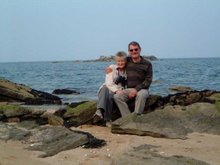8:30am sharp on the bus. We’re starting at the Spice Bazaar where tour guide Ali says the best Turkish delight is to be found. It looks very much like the Grand Bazaar, perhaps more elegant.
We’re led into an appropriate shop and given samples to try
. We aren’t keen on the Turkish delight you get in the UK, but this is
delicious so we buy some, as do most of the tour group. Can’t get over how much
the shop proprietor looks like Ali – they could be brothers!
Carrying on round the bazaar, I think it’s more interesting
than the Grand Bazaar. Look at all these loofahs for example.
And now numerous brass and copper pots hanging from the
ceiling, all guaranteed to produce a genie when rubbed - but only after you get
home!
After the bazaar, the bus heads for the Topkapi Palace, a vast building that housed the sultan and his entourage until the Turkish Republic came into being in 1923. It was built in the late 15th century by Sultan Mehemed II who had conquered Constantinople, as it was then called. Here’s the entrance, straight out of Disney.
The entrance portal itself merits a closer look with its
fine marble and Ottoman style script.
First port of call within the palace houses is the china collection. The cup – or is it a small bowl – is amazingly ornate but entirely
impractical. Most of the numerous exhibits could be similarly described.
Now the ante-room to the armoury. The tilework detail is
amazing as testimony to the wealth and power of the sultans.
The ceiling is even more stunning. They must have spent a
lot of time lying on the floor.
The armoury itself contains a variety of ancient weapons,
mostly quite similar to European types. These rifles are ornamented flintlocks,
purely for ceremonial use.
Moving on to the guards quarters, in fact where they slept, on these platforms. The palace guards were an elite corps chosen for their physique.
In 1923 when the Turkish Republic was founded the Sultan was turfed out and all the palaces closed so the eunuchs were out of work. They founded a self-help group known as the “Harem Eunuchs Mutual Assistance Society” which ended in the 1950s when the last ones died out.
And this is where some of the Harem slept. There were so
many different levels of inmate and consequent living conditions that it’s
impossible to generalise: some had incredibly pampered lives whilst others
perished due to neglect.
Now what did the sultans wear? Example: a robe of gold
thread, of ample proportions.
With matching boots, of course.
And a smart uniform for parade day. However, it looks nowhere
near generous enough and was no doubt an officer’s gear of around the mid 19th
century not a lot different to our own military garb of that era.
We leave Topkapi through the audience room. All rulers need
to be respected, revered and consulted.
We could have spent the whole week in the palace and didn’t
see all of it, but we’re on the move again: First lunch, then the boat trip.




















No comments:
Post a Comment